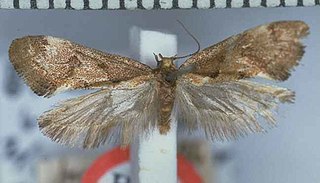
Trichoptilus ceramodes is a moth of the family Pterophoridae that is found in Australia, including New South Wales and South Australia.
Rhopalosetia is a monotypic moth genus in the family Copromorphidae. Its only species, Rhopalosetia phlyctaenopa, is found in French Guiana. Both the genus and species were first described by Edward Meyrick in 1926.
Depressaria togata is a moth in the family Depressariidae. It was described by Lord Walsingham in 1889. It is found in North America, where it has been recorded from Montana, from British Columbia to Arizona and in Oregon and Washington.
Helcystogramma xerastis is a moth in the family Gelechiidae. It was described by Edward Meyrick in 1905. It is found in Pakistan.
Dichomeris xerodes is a moth in the family Gelechiidae. It was described by Walsingham in 1911. It is found in Mexico (Tabasco).
Helcystogramma abortiva is a moth in the family Gelechiidae. It was described by Walsingham in 1911. It is found in Guatemala.
Helcystogramma juventellus is a moth in the family Gelechiidae. It was described by Thomas de Grey, 6th Baron Walsingham, in 1897. It is found in Jamaica and Mexico (Tabasco).

Chionodes obscurusella, the boxelder leafworm moth, is a moth in the family Gelechiidae. It is found in North America, where it has been recorded from Nova Scotia to Manitoba, south to North Carolina and Oklahoma.
Chionodes salva is a moth in the family Gelechiidae. It is found in the West Indies.
Battaristis symphora is a moth of the family Gelechiidae. It was described by Walsingham in 1911. It is found in Mexico (Tabasco).
Anacampsis conistica is a moth of the family Gelechiidae. It was described by Thomas de Grey, 6th Baron Walsingham, in 1910. It is found in Mexico.
Aristotelia squamigera is a moth of the family Gelechiidae. It was described by Walsingham in 1909. It is found in Mexico (Guerrero).
Ornativalva heligmatodes is a moth of the family Gelechiidae. It was described by Walsingham in 1904. It is found in Algeria and Tunisia.
Antaeotricha isochyta is a species of moth of the family Depressariidae. It is found in Guyana.
Anchinia porphyritica is a moth in the family Depressariidae. It was described by Edward Meyrick in 1914. It is found in Assam, India.
Antaeotricha milictis is a moth in the family Depressariidae. It was described by Edward Meyrick in 1925. It is found in Colombia and Brazil.
Antaeotricha praerupta is a moth in the family Depressariidae. It was described by Edward Meyrick in 1915. It is found in Guyana.
Moca aphrodora is a species of moth in the family Immidae first described by Edward Meyrick in 1922. It is found in Brazil and Peru.

Tingena ancogramma is a species of moth in the family Oecophoridae. It is endemic to New Zealand and has been found in the Hen and Chicken Islands, the North Island and the South Island. Adults are on the wing in summer and autumn and inhabit open areas of forest scrubland.

Tingena brachyacma is a species of moth in the family Oecophoridae. It is endemic to New Zealand and has been found in the south of the South Island. This species inhabits open swamps, native forest and scrubland and has been collected amongst Leptospermum. The adults of the species are on the wing in November and December.



